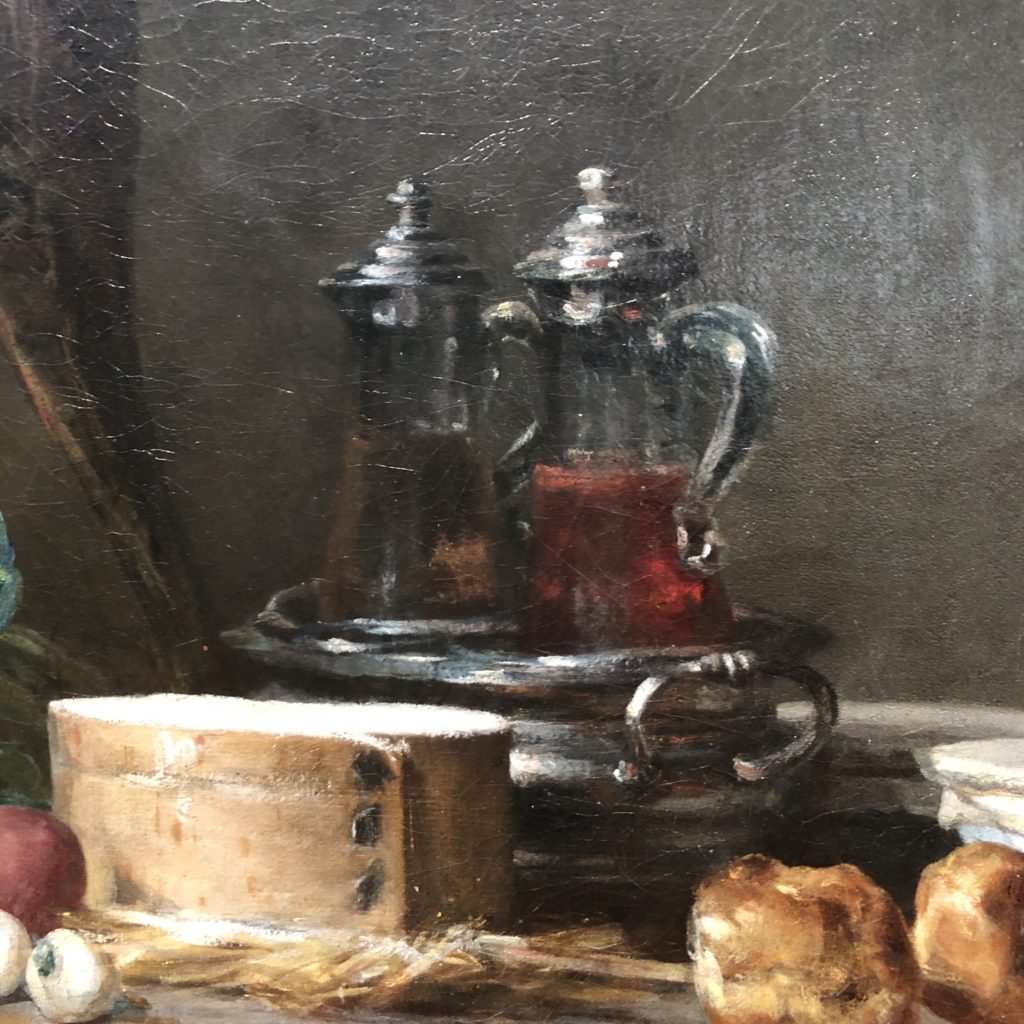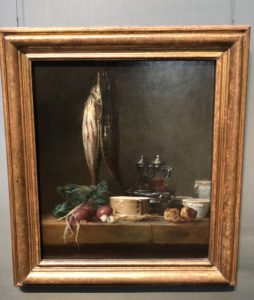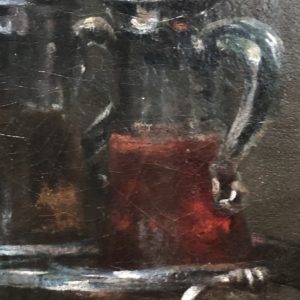Chardin’s dreaming

When I was a boy, I used to take a toy, whether or not it was meant to represent something aeronautically sound, and I would hold it out in front of me and “fly” it above the sofa mountains of our living room or, outside, over the terrain in our East St. Louis yard: a stone wall, peonies and day lilies, an actual manual pump (like the ones in Westerns) drawing air from an unproductive well, apple trees and woods. The scale of everything would be altered by whatever I was holding in my hand, an airplane, a Superman, or a scuba diver. I wanted to be a scuba diver more than anything in grade school. (Or a sardonic gambler with a six-shooter on my hip in a frontier Nebraska saloon.) A little molded plastic figure of a diver, lime green or blue, would swim over vast underwater canyons carpeted with bluegrass. I was the invisible giant holding him up: a giant or a god. The world was my diorama. Everything became more interesting.
 I get the same feeling looking at a close-up detail I shot a few months ago at The Getty of a masterful Chardin still life I’d never seen before. Up close, the objects on Chardin’s mantle look massive, like magical alien minarets and a flat-topped stadium, a terrain out of Gulliver’s Travels. It’s a strange city built with things from his kitchen. Bachelard would have been nudged by this scene into a reverie, another unique poetic measure of space, if he imagined everything in the picture a thousand times larger than its actual size. (I suppose you have to leave out the fish.) It becomes like one of those clockwork models of cities rising up out of the earth during the title sequence of Game of Thrones. This effect is partly what draws me to enlarged images of ordinary objects—making them massively larger on canvas than they are in my daily, disenchanted world—to bring out their formal resonance with so many other things with similar shapes and tones. In a way, I think this is related to what Braque meant in his notebooks about the centrality of transformation in painting, the alchemy that takes an ordinary interior space, full of utterly familiar things, and turns it into a painting’s dream. His transformations were more radical, obviously, but Chardin is just as concerned with the feel of the paint itself and the tactile quality of what’s seen–making you aware of the medium that invites you into its world, the same as yours, but cooler, fresher, more alive.
I get the same feeling looking at a close-up detail I shot a few months ago at The Getty of a masterful Chardin still life I’d never seen before. Up close, the objects on Chardin’s mantle look massive, like magical alien minarets and a flat-topped stadium, a terrain out of Gulliver’s Travels. It’s a strange city built with things from his kitchen. Bachelard would have been nudged by this scene into a reverie, another unique poetic measure of space, if he imagined everything in the picture a thousand times larger than its actual size. (I suppose you have to leave out the fish.) It becomes like one of those clockwork models of cities rising up out of the earth during the title sequence of Game of Thrones. This effect is partly what draws me to enlarged images of ordinary objects—making them massively larger on canvas than they are in my daily, disenchanted world—to bring out their formal resonance with so many other things with similar shapes and tones. In a way, I think this is related to what Braque meant in his notebooks about the centrality of transformation in painting, the alchemy that takes an ordinary interior space, full of utterly familiar things, and turns it into a painting’s dream. His transformations were more radical, obviously, but Chardin is just as concerned with the feel of the paint itself and the tactile quality of what’s seen–making you aware of the medium that invites you into its world, the same as yours, but cooler, fresher, more alive.
I was familiar with many of the objects in this picture from his other paintings, because he kept returning to these old inanimate friends again and again, as still life painters like to do: shallots, garlic, a couple gougeres (they look like cream puffs), several ceramic bowls with covers secured by lengths of twine, and a silver dish designed to hold two glass-and-silver cruets for oil and vinegar. Freshly-caught mackerel in the background are the wild card. Chardin did this at least a couple times—showing you fish and game ready for cooking. But he indicates the shining white underside of the fish with impasto streaks of paint uncharacteristic of his usually subtle handling. In a photograph, it looks right. In front of the actual painting, it distracted me and felt like the part of an overexposed photograph where highlights wash out into too much white. In the end, though, the problematic fish and the way he painted them make the painting even more interesting.
My detail shot is of the two cruets and a few other objects, and I’ve been gazing at them fondly this morning because of Chardin’s brushwork and his color. The ziggurat of silver tiers forming the lids on these cruets is done in such a way that it looks scrupulous about edges and mass. But the pair doesn’t even really match up: the stem for the rear cap is longer than it appears on the near one. Yet everything looks perfect. What’s so delightful, and triggers dreaming, is the way Chardin shows interior and exterior light on the surface of those cruets. If you look at the handle jutting toward you, behind it in the curve of the tray there are warm tones that echo the color of the vinegar while indicating something reddish in the room near where the painter was sitting. Maybe it’s what he’s wearing. It’s evident in the lid as well, little daubs of pink. So the warmth of the room, or the painter himself, itself shines back toward you subliminally. Yet in the S-shaped handle and the lip of the tray, you see the most perfect hint of blue/green/gray, the chillier glow of the  entire outside world concentrated into small areas that bank it toward your eyes. Somehow Chardin gets these areas of the cruets to look as if they are shiny objects covered with another skin of shine, a transparent glaze. A tiny world of greenery swims between the lights.
entire outside world concentrated into small areas that bank it toward your eyes. Somehow Chardin gets these areas of the cruets to look as if they are shiny objects covered with another skin of shine, a transparent glaze. A tiny world of greenery swims between the lights.
If anyone paints with this kind of mastery now—technique so skilled that it disappears into a seemingly unmediated translation of feeling into paint—I’m not aware of it. The close-up reminds me only of John Singer Sargent, except that Chardin’s brushwork isn’t showy. He was as confident as Sargent, but behind and around the visible brushwork are laborious and careful layers of glazing, like Vermeer’s but less exact in the result, and that’s the magic. Things seem to disappear into the recessed areas and yet persist. There was no flourish in his work, no flaunting his sorcery by resorting to Sargent’s swaths of paint, even though the surface is his obsession too, getting the paint to look almost as delectable as whatever it renders, the way Thiebaud does. From a foot away you see indefinite forms that resolve into clarity as you back away from the painting when your eyes find the weighty presence of whatever Chardin wanted you to see. The effect is to see both a seamless field of paint and also this delicately modulated scene lit by a nearby window, almost but not quite merging—in the shadows—into the wall behind it, alive with almost indiscernible shifts in tone, warm and cool, like a silty creek bed at the height of summer.
Comments are currently closed.